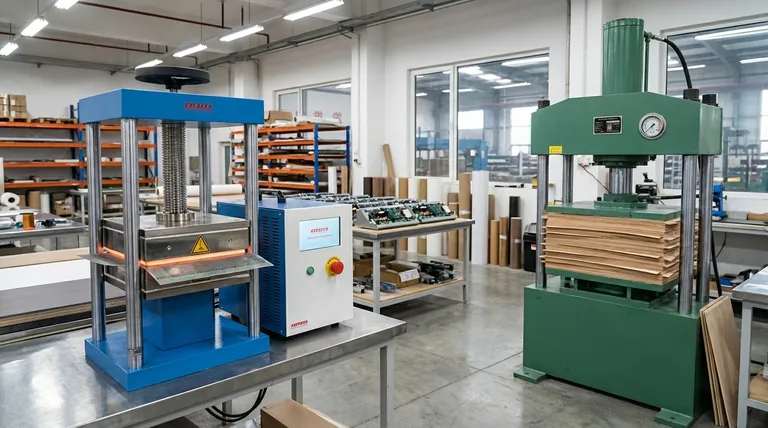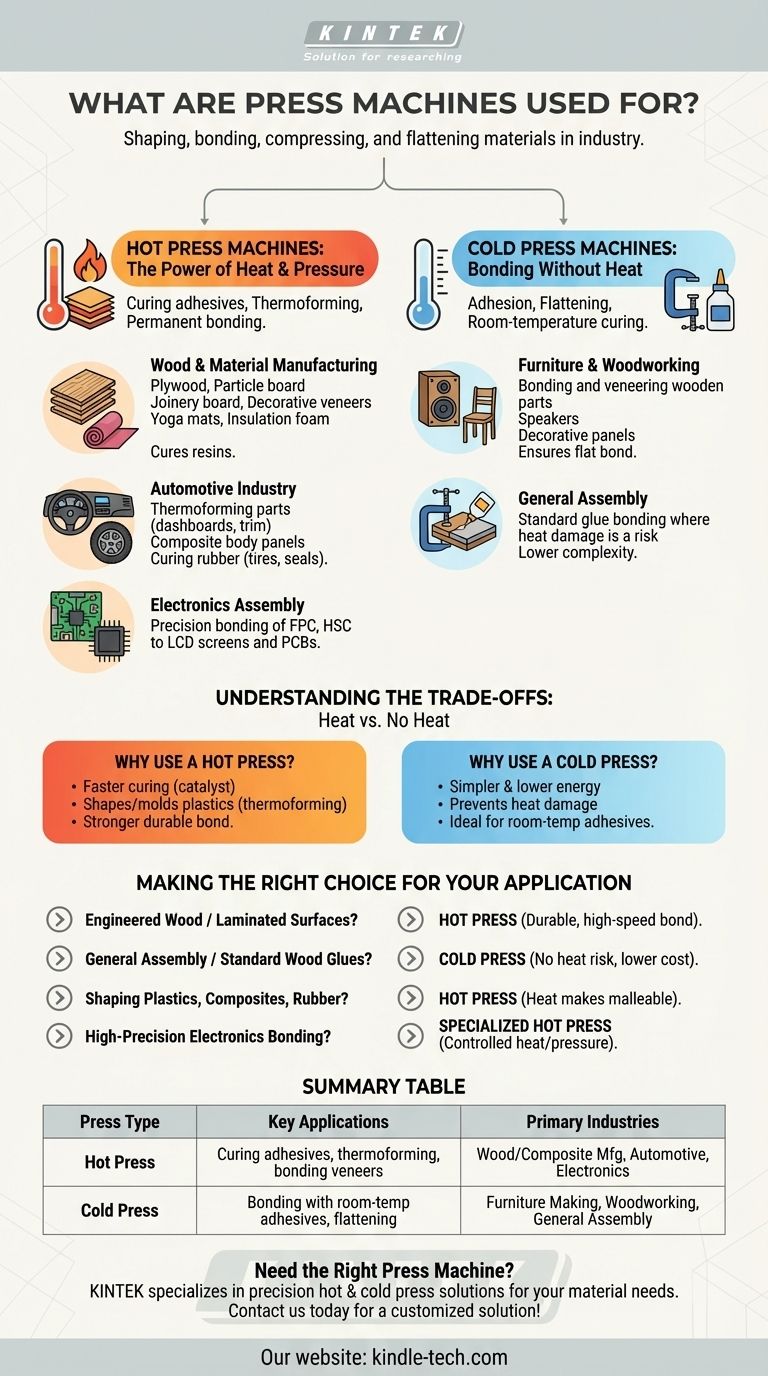Press machines are fundamental industrial tools used to apply significant pressure to a workpiece. Their purpose is to shape, bond, compress, or flatten a vast range of materials, from wood and plastic composites in manufacturing to delicate components in electronics assembly.
The term "press machine" is broad, but the most critical distinction is whether the process uses heat. A hot press uses both heat and pressure to form and bond materials, while a cold press relies on pressure alone at room temperature, fundamentally defining their specific industrial applications.

Hot Press Machines: The Power of Heat and Pressure
A hot press is essential when heat is required to cure an adhesive, shape a material (thermoforming), or create a permanent bond between layers.
In Wood and Material Manufacturing
Hot presses are the cornerstone of producing engineered wood products. They are used to manufacture man-made boards like plywood, particle board, and joinery board.
The heat and pressure work together to cure the resins that bond the wood fibers or veneers together. They are also used for applying decorative veneers and laminates to surfaces.
Beyond wood, these machines are crucial for creating common goods like yoga mats, mouse pads, and insulation foam by bonding and shaping the base materials.
In the Automotive Industry
The automotive sector relies heavily on hot presses for several critical processes. They are used for thermoforming plastic parts like dashboards, interior door panels, and trim components.
They also play a key role in manufacturing lightweight and strong composite material parts, including body panels, hoods, and roofs. Additionally, hot presses are used to cure rubber for components like tires and seals.
In Electronics Assembly
In a more precise application, specialized hot press machines are used for the connection of delicate electronic components.
This includes bonding FPC (flexible circuit board) and HSC (zebra paper) to LCD screens and PCBs, a process that requires carefully controlled heat and pressure to ensure a reliable connection.
Cold Press Machines: Bonding Without Heat
A cold press operates at normal ambient temperature, focusing entirely on the application of pressure. Its primary function is to hold materials together while an adhesive sets.
The Focus on Adhesion and Flattening
Cold presses are widely used in furniture making and woodworking. They are ideal for bonding and veneering wooden parts, such as in the production of speakers or decorative panels.
Their main purpose is to ensure a tight, flat, and even bond across a surface while the glue cures naturally. This makes them suitable for manufacturing plywood and particleboard when a heat-curing resin is not used.
Understanding the Trade-offs: Heat vs. No Heat
Choosing between a hot or cold press is dictated entirely by the material and the desired outcome.
Why Use a Hot Press?
Heat acts as a catalyst. It dramatically speeds up the curing time for adhesives, which significantly increases production efficiency.
For plastics and composites, heat is what makes the material pliable enough to be shaped or molded, a process known as thermoforming. The combination of heat and pressure often results in a stronger, more durable bond.
Why Use a Cold Press?
The primary advantage of a cold press is its simplicity and lower energy consumption. It is the ideal choice when working with materials that could be damaged by heat.
It is also perfect for applications where the adhesive is designed to cure at room temperature. While the cycle times may be longer due to natural curing, the machinery is less complex and often less expensive.
Making the Right Choice for Your Application
Your final decision depends on the materials you are working with and your production goals.
- If your primary focus is manufacturing engineered wood or laminated surfaces: A hot press is essential for curing resins and achieving a durable, high-speed bond.
- If your primary focus is general furniture assembly or veneering with standard wood glues: A cold press provides the necessary pressure for bonding without the risk of heat damage and with lower operational costs.
- If your primary focus is shaping plastics, composites, or rubber: A hot press is the only option, as heat is required to make these materials malleable.
- If your primary focus is high-precision electronics bonding: A specialized hot press with fine-tuned temperature and pressure controls is required.
Ultimately, understanding the role of heat in your process is the key to selecting the correct press machine for your specific industrial need.
Summary Table:
| Press Type | Key Applications | Primary Industries |
|---|---|---|
| Hot Press | Curing adhesives, thermoforming, bonding veneers | Wood/Composite Manufacturing, Automotive, Electronics |
| Cold Press | Bonding with room-temperature adhesives, flattening | Furniture Making, Woodworking, General Assembly |
Need the Right Press Machine for Your Lab or Production Line?
KINTEK specializes in precision lab equipment and industrial machinery, including hot and cold press solutions tailored to your material bonding, shaping, and compression needs. Whether you're working with composites, electronics, or wood products, our expertise ensures you get the right machine for optimal results.
Contact us today to discuss your application and receive a customized solution!
Visual Guide

Related Products
- Laboratory Hydraulic Press Split Electric Lab Pellet Press
- 24T 30T 60T Heated Hydraulic Press Machine with Heated Plates for Laboratory Hot Press
- Heated Hydraulic Press Machine with Heated Plates for Vacuum Box Laboratory Hot Press
- Laboratory Hydraulic Press Lab Pellet Press Machine for Glove Box
- Heated Hydraulic Press Machine with Heated Plates for Vacuum Box Laboratory Hot Press
People Also Ask
- What is the purpose of KBr pellets? Unlock Clear FTIR Analysis of Solid Samples
- How does pressure affect hydraulic system? Mastering Force, Efficiency, and Heat
- What is KBr disc method? A Complete Guide to IR Spectroscopy Sample Prep
- What is an example of a hydraulic press? Discover the Power of Laboratory Sample Preparation
- How much force can a hydraulic press exert? Understanding its immense power and design limits.



















